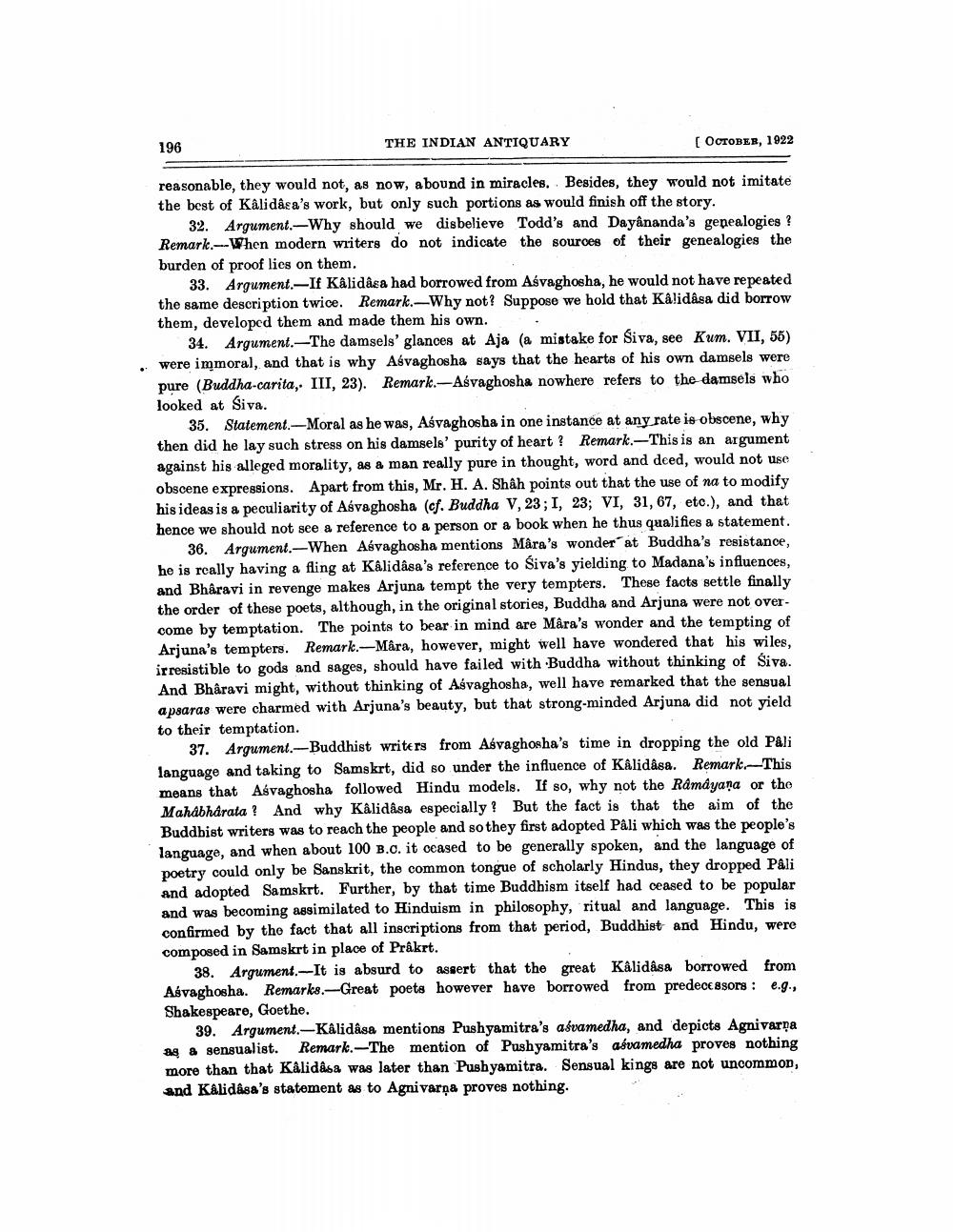________________
196
THE INDIAN ANTIQUARY
(OCTOBER, 1922
reasonable, they would not, as now, abound in miracles. Besides, they would not imitate the best of Kalidasa's work, but only such portions as would finish off the story.
32. Argument.-Why should we disbelieve Todd's and Dayananda's genealogies? Remark.--When modern writers do not indicate the sources of their genealogies the burden of proof lies on them.
33. Argument.-If Kalidasa had borrowed from Ašvaghosha, he would not have repeated the same description twice. Remark.-Why not? Suppose we hold that Kalidasa did borrow them, developed them and made them his own. .
34. Argument.-The damsels' glances at Aja (a mistake for Siva, see Kum. VII, 56) were immoral, and that is why Aśvaghosha says that the hearts of his own damsels were pure (Buddha-carita,. III, 23). Remark.--Ašvaghosha nowhere refers to the damsels who looked at Siva.
35. Statement.--Moral as he was, Ašvaghosha in one instance at any rate is obscene, why then did he lay such stress on his damsels' purity of heart? Remark.- This is an argument against his alleged morality, as a man really pure in thought, word and deed, would not use obscene expressions. Apart from this, Mr. H. A. Shâh points out that the use of na to modify his ideas is a peculiarity of Asvaghosha (cf. Buddha V, 23;1, 23; VI, 31, 67, etc.), and that hence we should not see a reference to a person or a book when he thus qualifies a statement.
36. Argument.-When Asvaghosha mentions Mâra's wonder at Buddha's resistance, he is really having a fling at Kalidasa's reference to Siva's yielding to Madana's influences, and Bhâravi in revenge makes Arjuna tempt the very tempters. These facts settle finally the order of these poets, although, in the original stories, Buddha and Arjuna were not overcome by temptation. The points to bear in mind are Mâra's wonder and the tempting of Arjuna's tempters. Remark.--Mâra, however, might well have wondered that his wiles, irresistible to gods and sages, should have failed with Buddha without thinking of siva. And Bhâravi might, without thinking of Asvaghosha, well have remarked that the sensual apsaras were charmed with Arjuna's beauty, but that strong-minded Arjuna did not yield to their temptation.
37. Argument.--Buddhist writers from Asvaghosha's time in dropping the old Påli language and taking to Samskrt, did so under the influence of Kalidasa. Remark,--This means that Asvaghosha followed Hindu models. If so, why not the Ramayana or the Mahabharata? And why Kalidasa especially? But the fact is that the aim of the Buddhist writers was to reach the people and so they first adopted Pâli which was the people's language, and when about 100 B.c. it ceased to be generally spoken, and the language of poetry could only be Sanskrit, the common tongue of scholarly Hindus, they dropped Pali and adopted Samskrt. Further, by that time Buddhism itself had ceased to be popular and was becoming assimilated to Hinduism in philosophy, ritual and language. This is confirmed by the fact that all inscriptions from that period, Buddhist and Hindu, were composed in Samskrt in place of Prakrt.
38. Argument.--It is absurd to assert that the great Kalidasa borrowed from Asvaghosha. Remarks.-Great poets however have borrowed from predecessors : e.g., Shakespeare, Goethe.
39. Argument.-Kâlidêsa mentions Pushyamitra's aśvamedha, and depicts Agnivarna Ag & sensualist. Remark.-The mention of Pushyamitra's asvamedha proves nothing more than that Kalidasa was later than Pushyamitra. Sensual kings are not uncommon, and Kalidasa's statement as to Agnivar a proves nothing.




